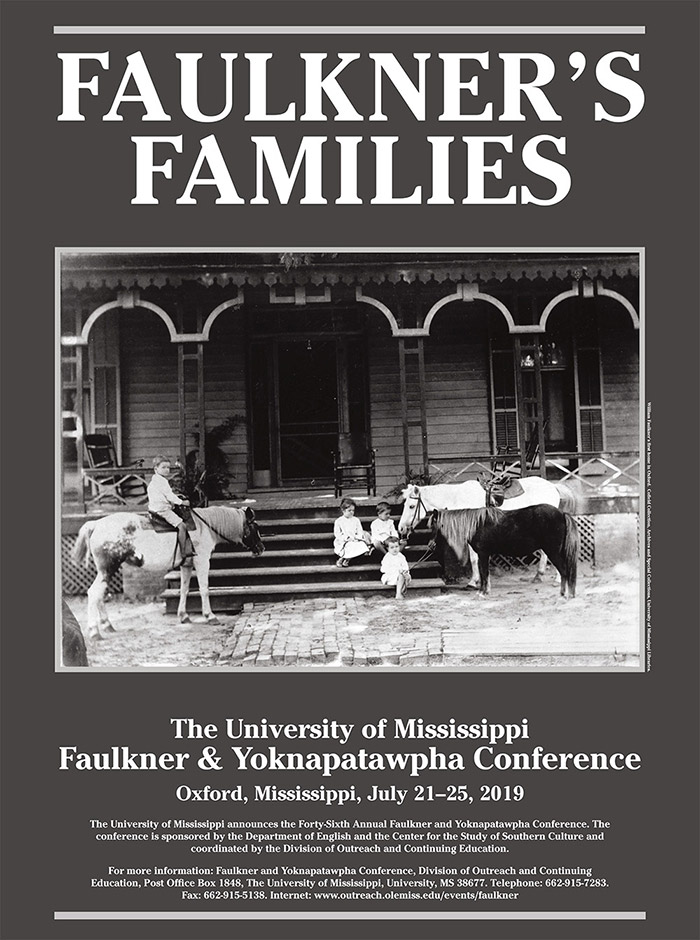
Digital Yoknapatawpha Update
Location
Nutt Auditorium
Website
http://faulkner.iath.virginia.edu/
Start Date
22-7-2019 12:30 PM
Description
Box lunch available upon request.
- Faulkner’s Familial Places: Kinship and Demography in the Digital Yoknapatawpha Database / Johannes Bergers, Ashoka University
The topography of Faulkner’s county is etched with the names of the men and women who made it, from “the proud fading white plantation names” to the “cradle of Varners and ant-heap of the northeast crawl of Snopes.” Using advanced GIS visualizations made with data from the Digital Yoknapatawpha Database, this presentation showcases the spatio-temporal relationships between kinship and demography across Faulkner’s Yoknapatawpha Fictions. Compressing all his fictions onto one map reveals just how consistently Faulkner mapped the spaces of Jefferson county. In particular, it underscores the extent to which kinship patterns are co-extensive with other changing demographic relations. Indeed, kinship appears to function as a synecdoche for larger demographic patterns, and is therefore a crucial intermediary for understanding the relationship between Faulkner’s individuals and their community. - Abandoning the Desire for ‘Wholeness’: Digital Yoknapatawpha and the ‘Compson Appendix’ / Erin Penner, Asbury University
If Malcolm Cowley curated Yoknapatawpha for readers of The Portable Faulkner, how do current scholars shape the way Faulkner’s work is presented in Digital Yoknapatawpha? Cowley hoped to use The Portable Faulkner to represent Faulkner’s work “as a whole,” but Cowley’s vision is not that of the editors of Digital Yoknapatawpha, even if they echo his desire to gather the stories of Faulkner’s fictional county in one place. Unlike Cowley, DY makes it difficult to create a view of Yoknapatawpha that comes at the cost of individual Faulkner works. Faulkner stages that very battle in the “Compson Appendix”; although Jason Compson IV claims a central role in both The Sound and the Fury and the “Appendix,” it is Melissa Meek, a character outside the family, who best captures Faulkner’s “growing, changing” Compson family narrative in the later text. - Faulkner’s Families: Digital Yoknapatawpha in the Classroom / Jenna Grace Sciuto, Massachusetts College of Liberal Arts
This presentation will share practical approaches to engaging with Digital Yoknapatawpha in the classroom to enrich students’ experiences with William Faulkner’s novels. I will demonstrate the ways in which my students’ understandings of family dynamics across The Sound and the Fury and Go Down, Moses were directly enhanced through work with the character-character graphs of Digital Yoknapatawpha. I consider what is added to students’ understandings of the novels through a hybrid assignment—a short comparative analysis paper requiring students to put two texts in conversation with each other, a novel by Faulkner and a graph or chart from the site. The character graphs can help clarify the reality of relationships or crystalize aspects of family dynamics in the novels, which can then be expanded and developed by students through close textual work.
Relational Format
Conference proceeding
Recommended Citation
Bergers, Joost; Penner, Erin; and Sciuto, Jenna Grace, "Digital Yoknapatawpha Update" (2019). Faulkner and Yoknapatawpha Conference. 10.
https://egrove.olemiss.edu/fy/2019/schedule/10
COinS
Jul 22nd, 12:30 PM
Digital Yoknapatawpha Update
Nutt Auditorium
Box lunch available upon request.
- Faulkner’s Familial Places: Kinship and Demography in the Digital Yoknapatawpha Database / Johannes Bergers, Ashoka University
The topography of Faulkner’s county is etched with the names of the men and women who made it, from “the proud fading white plantation names” to the “cradle of Varners and ant-heap of the northeast crawl of Snopes.” Using advanced GIS visualizations made with data from the Digital Yoknapatawpha Database, this presentation showcases the spatio-temporal relationships between kinship and demography across Faulkner’s Yoknapatawpha Fictions. Compressing all his fictions onto one map reveals just how consistently Faulkner mapped the spaces of Jefferson county. In particular, it underscores the extent to which kinship patterns are co-extensive with other changing demographic relations. Indeed, kinship appears to function as a synecdoche for larger demographic patterns, and is therefore a crucial intermediary for understanding the relationship between Faulkner’s individuals and their community. - Abandoning the Desire for ‘Wholeness’: Digital Yoknapatawpha and the ‘Compson Appendix’ / Erin Penner, Asbury University
If Malcolm Cowley curated Yoknapatawpha for readers of The Portable Faulkner, how do current scholars shape the way Faulkner’s work is presented in Digital Yoknapatawpha? Cowley hoped to use The Portable Faulkner to represent Faulkner’s work “as a whole,” but Cowley’s vision is not that of the editors of Digital Yoknapatawpha, even if they echo his desire to gather the stories of Faulkner’s fictional county in one place. Unlike Cowley, DY makes it difficult to create a view of Yoknapatawpha that comes at the cost of individual Faulkner works. Faulkner stages that very battle in the “Compson Appendix”; although Jason Compson IV claims a central role in both The Sound and the Fury and the “Appendix,” it is Melissa Meek, a character outside the family, who best captures Faulkner’s “growing, changing” Compson family narrative in the later text. - Faulkner’s Families: Digital Yoknapatawpha in the Classroom / Jenna Grace Sciuto, Massachusetts College of Liberal Arts
This presentation will share practical approaches to engaging with Digital Yoknapatawpha in the classroom to enrich students’ experiences with William Faulkner’s novels. I will demonstrate the ways in which my students’ understandings of family dynamics across The Sound and the Fury and Go Down, Moses were directly enhanced through work with the character-character graphs of Digital Yoknapatawpha. I consider what is added to students’ understandings of the novels through a hybrid assignment—a short comparative analysis paper requiring students to put two texts in conversation with each other, a novel by Faulkner and a graph or chart from the site. The character graphs can help clarify the reality of relationships or crystalize aspects of family dynamics in the novels, which can then be expanded and developed by students through close textual work.
https://egrove.olemiss.edu/fy/2019/schedule/10

